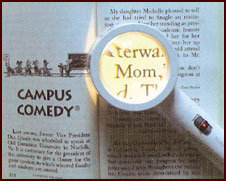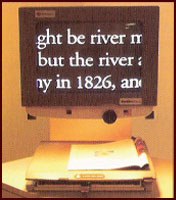What is low vision?
Low vision is a loss of eyesight that makes everyday tasks difficult. A person with low vision may find it difficult or impossible to accomplish such activities as reading, writing, shopping, watching television, driving a car, recognizing faces, and crossing the street. When vision cannot be improved with regular eyeglasses, medicine, or surgery, people with low vision need help to learn how to make the most of their remaining sight and keep their independence.
What causes low vision?
Low vision can be caused by eye injuries or by diseases such as :
• macular degeneration;
• glaucoma;
• diabetic retinopathy;
• retinitis pigmentosa.
These conditions can occur at any age but are more common in older people. Normal aging of the eye does not lead to low vision. Regular medical eye exams by an ophthalmologist (Eye M.D.) are important to diagnose eye diseases, treat those conditions that can be helped, and start the process of vision rehabilitation for people with low vision.
What can be done to help?
Vision rehabilitation can help people with low vision compensate for their vision loss, much as rehabilitation helps people with heart disease, arthritis, and stroke. You can learn new strategies to complete daily activities. By mastering new techniques and devices, you can regain confidence and live independently in spite of vision loss.
This can be a challenging and frustrating period of adjustment–one that requires patience, practice, motivation, and the support of your doctor, low vision specialist, family and friends. Yet the rewards can be invaluable: being able to function better in your daily life.
The amount of rehabilitation needed depends on your vision loss and what you want to be able to do.
A team approach is often best and may involve some or all of these professionals: ophthalmologist, low vision specialist, occupational therapist, rehabilitation teacher, orientation and mobility specialist, social worker, or counselor.
Low-vision aids
Many devices can help people with low vision make the most of their remaining vision to function better and enhance their quality of life. Different devices may be needed for different tasks. Before purchasing a device, consider talking to a trained professional who can help you determine what will best meet your needs. Remember that you will need training and practice to become skilled at using any device.
OPTICAL LOW VISION AIDS
optical low vision devices use lenses to magnify objects, making them easier to see.
Magnifying spectacles are stronger than ordinary glasses. They can be used for near tasks such as reading, threading a needle, or any activity that requires close, detailed vision. using them requires holding the printed page or object closer than usual in order to keep things in focus. With practice, this becomes comfortable. An advantage of magnifying spectacles is that the hands remain free to hold the reading materials or perform tasks.

Illuminated Stand Magnifier
Stand magnifiers rest directly on the reading material, keeping the lens at the proper distance from the page. Some stand magnifiers also have a built–in light.
The ability to rest the magnifier on the page is useful for patients with a tremor or arthritis.
Hand magnifiers are available in varying strengths to suit different people and different tasks. Reading material is not necessarily held as close to the face as with magnifying spectacles. Some models come with a built–in light. High–quality and high–powered magnifiers are often available only in specialized stores or through vision rehabilitation professionals.
Telescopes are used for seeing faraway objects or signs. They can be hand–held like a pair of regular binoculars or mounted on a pair of eyeglasses.
Video magnifiers are electronic devices that use a camera and television screen to enlarge printed material, pictures, or small objects. They are adjustable and can enhance the material in different ways. For example, a video magnifier can make the print appear darker (increased contrast). The technology is developing rapidly, and electronic devices are becoming smaller, more portable and easier to use. Some can even be used for both distance and near tasks.
OTHER LOW VISION DEVICES AND TECHNIQUES

Video magnifier
There are numerous low vision aids, devices, and techniques to help make everyday activities easier.
They include :
• large-print books, newspapers, magazines, playing cards, and checks;
• techniques such as writing and signing guides to highlight the area of
interest;
• high-contrast and large-number telephones, thermostats, watches, and
remote controls;
• talking watches, timers, books and blood pressure and blood sugar
machines;
• bold-tipped markers for easy-to read shopping and phope number lists;
• computers that can magnify, on screen or on paper, any printed material or picture;
• computers that read aloud what is viewed on screen;
• modifying your usual habits, such as sitting closer to the television.
(This will not damage your eyes!)
Lighting and glare
Good lighting and control of glare are very important for most people with low vision. Here are some useful suggestions :
A bright light close to reading material often improves vision. Adjust its location for the greatest visibility without glare.
In dimly lit areas, stronger light bulbs can make tasks like cooking, dressing, and walking up or down stairs easier.
Wearing a hat with a wide brim or tinted wrap-around sunglasses can shield your eyes from dazzling and annoying overhead lights or sunlight.
Where to get help?
Vision rehabilitation services may be provided by doctors, hospitals, vision rehabilitation centers, and government and private agencies. Ask your ophthalmologist or contact the organizations below for more information and resources near you.
American Foundation for the Blind
11 Penn plaza, Suite 300
New York, NY 10001 (800) 232–5463
www.afb.org
Lighthouse International
111 East 59th Street
New York, NY 10022
(800) 829–0500
www.lighthouse.org
National Association for visually Handicapped
22 West 21 st Street
New York, NY 10010
(212) 889–3141
www.navh.org
National Library Service for the Blind and Physically Handicapped
Library of congress
1291 Taylor Street, NW
washington, DC 20542
(800) 424–8567
www.loc.gov/nls



